What Is a Relay?
What is a relay? A relay is an electromechanical switch that is operated electrically instead of mechanically like traditional switches. A relay is a unique type of switch because it works using an electromagnet to either open or close a circuit. However, newer versions of relays use electronics such as a solid-state relay but work using the same principle.
Relays are used when a lower power signal is required to control a circuit or many control circuits by one signal. A relay allows for complete electrical isolation between the controlling and controlled circuit.
The current used to control a relay varies from DC and AC. It may be a low voltage such as DC at 5 V, 12 V or 24 V or voltages of AC at 24 V up to 120 V.

How Does A Relay Work?
A traditional relay consists of a coil of wire wrapped around an iron core, a movable armature and a yoke. The armature is mechanically attached to the yoke so it can act as a lever and close the contacts when the relay receives a signal.
When a relay receives an electrical current it is passed through the coil, which generates a magnetic field. The magnetic field results in the activation and subsequent movement of the armature. The armatures movement results in the levering of the yoke and consequentially closes (or opens depending on design) the contacts.
The armature is generally spring-loaded so that in an unenergized state, it is constantly closed or open, depending on the type and design of the relay. A strong force is usually required to disengage the contacts to help reduce noise in low voltage conditions but, more importantly, reduce arcing between contacts in high voltage conditions.
Relays also act as isolators because the input and output of the device are not electrically connected – allowing you to protect the device.
Main Parts of A Relay
There are two main circuits in each relay, a primary and secondary. The purpose of the primary circuit is to provide a signal to operate the relay. For example, a switch, a sensor etc. The secondary circuit is the circuit that contains the load and needs to be controlled. A load is a component that will consume electricity, for example, a light bulb, pump, fan etc.
Relay Phrases
Relays follow a similar terminology to switches as they are similar devices.
Normally Open (NO) – Normally Open means that when the coil is energised, the contacts are closed and energised the circuit.
Normally Closed (NC) – Normally closed means that when the coil is energised, the contacts are open de-energising the circuit.
Types of Relays
There are many different types of relays available for a variety of applications. Here we will cover the most well-known types of relays
Common Electrical Relay Contact Forms:
– SPST-NO – Single Pole – Single Throw, Normally Open. This type of contact has a single make contact which consists of two terminals that can be connected or disconnected.
– SPST-NC – Single Pole – Single Throw, Normally Closed. This type of contact has a break contact that consists of two terminals.
Force-Guided Contacts Relay
Force guided contacts relays, as the name suggests, have the contacts of the relay mechanically linked. The mechanical linkage allows the contacts to move together when the relay coil is energised or de-energised. These types of relays are also referred to as ‘mechanically linked contacts’, ‘safety relays’ and ‘positive guided contacts’.
The primary function of the mechanical linkage between the contacts is to act as a safety device. If one set of contacts in the relay are unable to move, then the rest of the contacts in that relay will also not be able to move.
The safety function of force guided contacts relay is highlighted by its ability to prevent contacts from being in opposite states. However, this does not guarantee that all contacts are in the same state.
Contactor
A contactor is used for switching lights and electric motors, hence using higher electrical currents and is heavy-duty. Due to the high current rating of the relay, arcing between the contacts is inventible. As a result, alloys comprising silver are used as the contact material.
The effect of arcing causes the contact material to oxidise, and silver oxide is a good conductor making the use of alloys containing silver preferable for high current relays. Contactor relays are commonly used in start motors for vehicles.
Latching Relay
A latching relay is also known as a bistable, keep, or impulse relay. A latching relay maintains a contact position when there is no power to the relay. It is controlled by two switches, one that sets it in position and the other resets it. Once, the actuating switch has been released, the latching relay maintains its position, performing a basic memory function.
Advantages of Relays
– It allows the control of large power circuits from low power signals.
– Can contain multiple contact sets which allow loads with different operating voltages can be controlled using the same signal.
– They can be easily tested while still in a circuit because many models have a manual switch on top
– Relays are powered by AC and DC
Summary
A relay is an electromechanical component and work in a range of environments but have the major benefit of allowing large power circuits to be controlled using lower power signals. Once understood, they are relatively straightforward to understand and diagnose.
A relay can work when powered by both AC and DC, making them versatile components. We have covered different types of relays and phrases associated with the devices, and hopefully, your knowledge of them has been expanded.
- Related Posts:
- What Is Sustainable Energy and Why Is It Important?
- Will Mechanical Engineers Be Needed In The Future?
The Graduate Engineer Social Media




